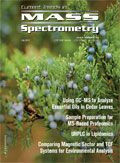ASMS Review
Special Issues
We present a brief review of this year's ASMS conference, which took place June 9–13, 2013, in Minneapolis, Minnesota.
We present a brief review of this year's ASMS conference, which took place June 9–13, 2013, in Minneapolis, Minnesota.
The 61st Conference on Mass Spectrometry and Allied Topics took place this year June 9–13 at the Minneapolis Convention Center in Minneapolis, Minnesota. The Sunday opening got under way with short courses taking place throughout the day, a tutorial session from 5:30 p.m. to 6:30 p.m., and the conference opening lecture at 6:45 p.m. The tutorials were given by Andrew Hoofnagle of the University of Washington and John Engen of Northeastern University. Hoofnagle's talk focused on the wide spectrum of clinical diagnostics for the masses. Engen spoke about the nuts and bolts of protein hydrogen exchange mass spectrometry.

(PHOTO CREDIT: JOSH ERAL/GETTY IMAGES)
The opening lecture was given by Michael L. Gross of Washington University of St. Louis, on "The First Fifty Years of MS: Building a Foundation."
Three more plenary events took place during the week. The Monday and Tuesday plenary sessions were award lectures given by Richard D. Smith and Yinsheng Wang (details below). On Thursday, Peter Onyisi of the University of Texas at Austin gave a plenary talk on the discovery of the Higgs boson. And as in previous years, the conference also featured daily oral sessions, poster sessions, exhibits, and workshops.
Awards
Several awards were presented at this year's conference. The Award for a Distinguished Contribution in Mass Spectrometry was presented on Monday afternoon to Richard D. Smith of the Pacific Northwest National Laboratory for the development of the electrodynamic ion funnel in his laboratory. With the ion funnel, Smith has provided a basis to greatly improve mass spectrometers, today allowing routine detection of low-concentration species that would have been undetectable 15 years ago.
The Biemann Medal went to Yinsheng Wang of the University of California, Riverside, for his research on discovering the biological consequences of DNA damage and on unraveling mechanisms of action for antitumor drugs and environmental toxicants. His laboratory developed a method that combined liquid chromatography–tandem mass spectrometry (LC–MS-MS) with a plasma-based shuttle vector approach to quantitatively assess how structurally defined DNA lesions alter the frequency and efficiency of DNA replication and transcription in cells, and to measure the types and frequencies of mutations induced by lesions.
Two other awards were given out at this year's conference. Yu Xia of Purdue University and Matthew F. Bush of the University of Washington each received the ASMS Research Award, which was funded by Thermo Scientific and Waters Corporation. The Ron Hites Award for an Outstanding Research Publication in the Journal of the American Society for Mass Spectrometry was presented to Alexander W.G. Graham, Steven J. Ray, Christie G. Enke, Charles J. Barinaga, David W. Koppenaal, and Gary M. Hieftje for a paper titled "First Distance-of-Flight Instrument: Opening a New Paradigm in Mass Spectrometry."
ASMS 2014
The 62nd Annual ASMS Conference will be held June 15–19, 2014, in Baltimore, Maryland. For more information, visit www.asms.org in the coming months.

Biopharmaceutical Characterization in the Age of Artificial Intelligence
May 13th 2025AI-powered tools are enhancing precision, efficiency, and decision-making in biopharmaceutical development. Recently, Jared Auclair and Anurag Rathore explored AI's evolving role in biopharmaceuticals in detail.
Determining Ways to Protect Honeybee Colonies with GC–MS
May 13th 2025A study conducted by the Agriculture Research Centre of Giza, Egypt, and Jilin Agricultural University in China, evaluated the efficacy of stinging nettle extract, nettle smoke, and formic acid in the controlling of Varroa mites, a major threat to honeybee colonies, with a focus on mite infestation reduction, honeybee mortality, and biochemical responses. Gas chromatography–mass spectrometry (GC–MS) was used to identify key bioactive compounds in the stinging nettle extract.
Evaluating the Accuracy of Mass Spectrometry Spectral Databases
May 12th 2025Mass spectrometry (MS) can be effective in identifying unknown compounds, though this can be complicated if spectra is outside of known databases. Researchers aimed to test MS databases using electron–ionization (EI)–MS.

.png&w=3840&q=75)

.png&w=3840&q=75)



.png&w=3840&q=75)



.png&w=3840&q=75)











